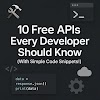So you've heard about Google AdSense, that magical system that pays you when people visit your site and click on ads. But... how does it really work? How do you get started? How do you avoid getting banned or stuck with zero earnings?
This guide is the complete, no-BS walkthrough for developers and tech bloggers who want to monetize their websites smartly. Whether you're running a blog, coding portfolio, tutorial site, or tool-based web app, this guide is for you.
🧠 What You’ll Learn
By the end of this tutorial, you’ll know how to:
- Get AdSense approval fast (even in 2025)
- Set up your site the right way
- Understand where and how to place ads for max earnings
- Avoid common mistakes that get devs banned
- Use AdSense with tools like Blogger, WordPress, React, or custom HTML/PHP apps
📌 Step 1: Understand What Google AdSense Is
Google AdSense is a program that lets you display ads on your website and earn revenue when:
- Someone views the ad (CPM — cost per thousand impressions)
- Someone clicks the ad (CPC — cost per click)
You earn more when:
- Your content is valuable (tutorials, resources, etc.)
- You attract organic traffic from search engines
- You write content in high-paying niches (like finance, tech, AI)
⚙️ Step 2: Prepare a Site That Qualifies
AdSense has strict policies in 2025. Here’s what you need before applying:
✅ Required Pages
- About
- Contact
- Privacy Policy
- Terms & Conditions (optional but good)
✅ Content Requirements
- At least 15–20 posts with original content
- Posts should be 500–1000+ words
- Use images, code snippets, and useful formatting
💡 Tech bloggers: Code snippets are welcome, but your site should also be human-readable. Add explanations and real-world context.
📄 Step 3: Add Your Site to AdSense
Once your site is ready:
- Go to https://www.google.com/adsense
- Sign in with your Google account
- Enter your website domain
- AdSense will give you a verification code
🔐 Add the Verification Code to <head>
If you're using HTML, Blogger, or WordPress (with custom code), paste the code like this:
<head>
<!-- AdSense verification -->
<meta name="google-site-verification" content="YOUR_VERIFICATION_CODE_HERE" />
</head>
AdSense will crawl your site and check for eligibility. This may take 2–14 days.
🖼️ Step 4: Add Your First Ad Unit
After approval, you'll be able to access the AdSense dashboard.
- Go to Ads > Overview
- Click “By ad unit”
- Choose “Display ads” or “In-feed ads”
- Name your unit and pick size (Responsive recommended)
🎯 Place the Code in Your HTML
You’ll get a code snippet like this:
<!-- AdSense Ad Unit -->
<ins class="adsbygoogle"
style="display:block"
data-ad-client="ca-pub-XXXXXXXXXXXXXXXX"
data-ad-slot="1234567890"
data-ad-format="auto"
data-full-width-responsive="true"></ins>
<script>
(adsbygoogle = window.adsbygoogle || []).push({});
</script>
Place it inside your content, like below a blog title, between paragraphs, or in the sidebar.
Want a smarter layout? Check out our Frontend Lab for ad-placement-friendly UI tips.
🔁 Step 5: Optimize Ad Placement
✅ Best Practices
- Use 2–3 ad units per page
- Place one after the first paragraph
- One mid-content
- One in the sidebar or footer
Too many ads = poor UX and possible policy violations.
🧠 Pro Tip: Use heatmaps (like Hotjar) to see where users engage most.
🚫 Common AdSense Mistakes to Avoid
❌ Don’t do this:
- Copy/pasting content from ChatGPT or other sites without editing
- Clicking on your own ads (instant ban!)
- Using misleading labels like “Click here to support us”
- Placing ads too close to buttons or navigation
- Having thin content pages (less than 300 words)
🧮 Bonus: Estimate Your AdSense Earnings
Here’s a rough formula:
Daily Earnings = (Daily Page Views / 1000) * CTR * CPC
- Average CTR: 1%–2%
- CPC (Cost per Click): $0.10–$2.00 depending on niche
- Traffic matters most! Focus on SEO, not just ads.
Check out our SEO for developers guide to bring in real traffic.
🚀 Best Practices & Tips
- Write tutorials, how-tos, and niche-focused posts (e.g., “How to build a Python API with Flask”)
- Add internal linking to reduce bounce rate and improve AdSense RPM
- Improve site speed — use tools like PageSpeed Insights
- Avoid too many popups or intrusive banners
- Regularly update older content for freshness
💡 Why This Matters for Developers & SEO
Running AdSense on your blog doesn't just mean earning money — it motivates you to:
- Publish consistently
- Focus on solving real-world problems
- Build SEO-friendly, accessible websites
Plus, Google prioritizes helpful content, so dev-focused blogs often outperform generic blogs in search.
🙌 Conclusion
Google AdSense is a legit, passive income stream — but only if you treat your site like a real project. Focus on value, play by the rules, and experiment with ad layouts that feel natural, not spammy.
You got this! 👊
Got questions or want us to review your blog? Drop a comment or join our community below!












0 Comments